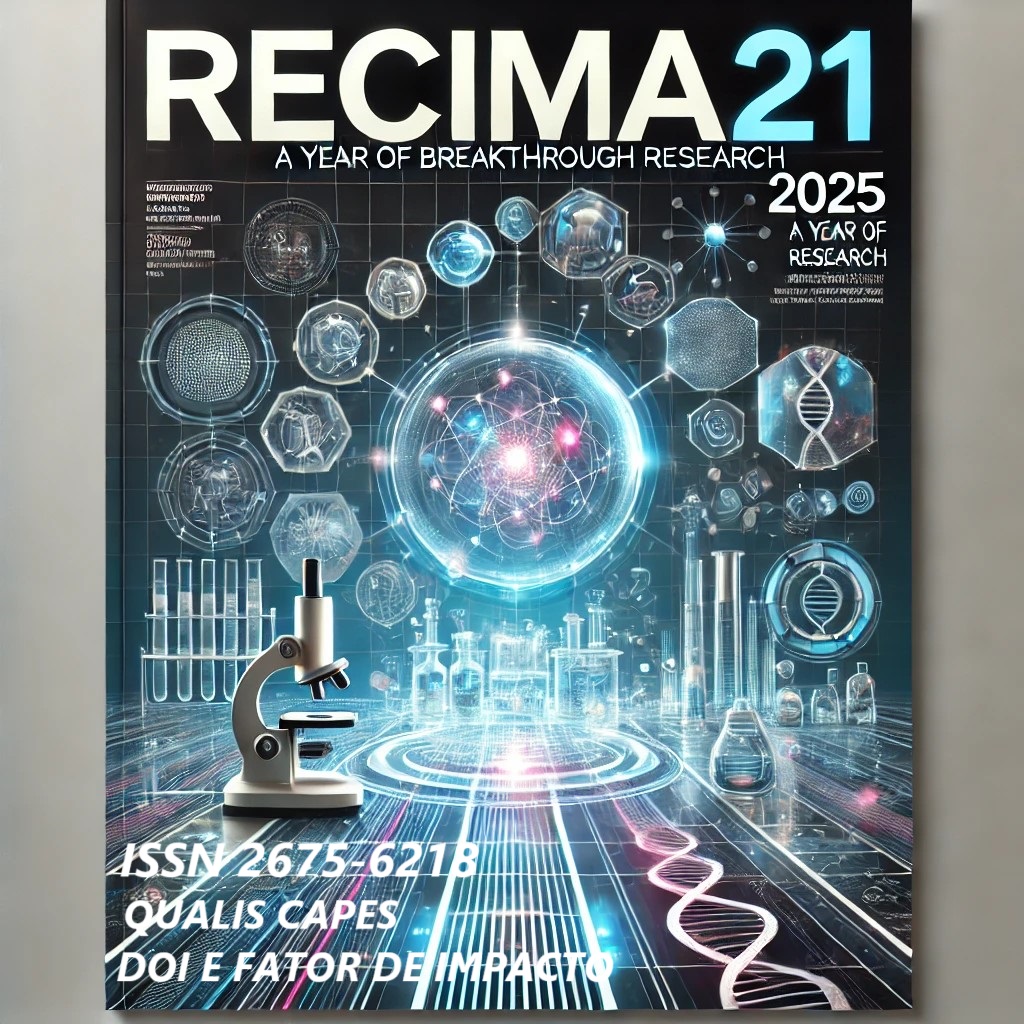TENDENCIAS DE LA OBESIDAD EN BRASIL Y SU RELACIÓN CON LAS ENFERMEDADES CARDIOVASCULARES
DOI:
https://doi.org/10.47820/recima21.v6i4.6350Palabras clave:
Obesidad, Enfermedades cardiovasculares, EpidemiologíaResumen
La obesidad es un grave problema de salud pública en Brasil, con un crecimiento alarmante que impacta directamente en el aumento de las enfermedades cardiovasculares (ECV). Factores como el consumo excesivo de alimentos ultraprocesados y el sedentarismo han contribuido a esta epidemia, afectando a todas las edades, especialmente a niños y adolescentes, lo que eleva el riesgo de complicaciones cardiovasculares en la edad adulta. Un estudio realizado entre 2020 y 2024, utilizando datos del Sistema de Información Hospitalaria (SIH/DATASUS), mostró un aumento en las hospitalizaciones y muertes relacionadas con la obesidad, reforzando su vínculo con las ECV. Las mujeres fueron las más afectadas, posiblemente debido a factores hormonales y de comportamiento, y la región sudoriental registró el mayor número de casos, reflejando su alta densidad poblacional y desigualdades en el acceso a la salud. La obesidad está relacionada con mecanismos como la resistencia a la insulina, dislipidemia, inflamación crónica e hipertrofia ventricular. La acumulación de grasa visceral desencadena la liberación de sustancias inflamatorias, acelerando procesos como aterosclerosis, hipertensión, infartos y accidentes cerebrovasculares. Además, aumenta la retención de sodio y agua, elevando la presión arterial. Es urgente implementar estrategias para prevenir y controlar la obesidad, reduciendo el impacto de las ECV. Políticas públicas que promuevan la educación nutricional, la actividad física y regulen el entorno alimentario son esenciales. Un enfoque multidisciplinario, con diagnóstico precoz y tratamiento adecuado, puede reducir las complicaciones cardiovasculares, mejorando la salud de la población brasileña.
Descargas
Referencias
BULL, Fiona C. et al. Diretrizes da Organização Mundial da Saúde 2020 sobre atividade física e comportamento sedentário. British Journal of Sports Medicine, v. 54, n. 24, p. 1451-1462, 2020. DOI: 10.1136/bjsports-2020-102955. DOI: https://doi.org/10.1136/bjsports-2020-102955
CARLUCCI, Edilaine Monique de Souza et al. Obesidade e sedentarismo: fatores de risco para doença cardiovascular. Comunicação em Ciências da Saúde, v. 24, n. 4, p. 375-384, 2013.
CIĘŻKI, Sebastian; ODYJEWSKA, Emilia; BOSSOWSKI, Artur; GŁOWIŃSKA-OLSZEWSKA, Barbara. Not Only Metabolic Complications of Childhood Obesity. Nutrients, v. 16, n. 4, p. 539, 2024. DOI: 10.3390/nu16040539. DOI: https://doi.org/10.3390/nu16040539
COSTA, Larissa Silva Gradil et al. Prevalência das internações hospitalares por obesidade no Brasil, entre 2018 e 2022. Brazilian Journal of Implantology and Health Sciences, v. 5, n. 4, p. 1395-1406, 2023. DOI: 10.36557/2674-8169.2023v5n4p1395-1406. DOI: https://doi.org/10.36557/2674-8169.2023v5n4p1395-1406
CUNHA, Claudio Leinig Pereira da. A influência da obesidade e da atividade física no risco cardiovascular. Arquivos Brasileiros de Cardiologia, v. 119, n. 2, p. 244-245, 2022. DOI: 10.36660/abc.20220381. DOI: https://doi.org/10.36660/abc.20220381
FERNANDES, Renata Cordeiro et al. Sobrepeso e obesidade entre mulheres e associação com características demográficas e obstétricas entre usuárias de uma unidade de saúde especializada. Cadernos de Saúde Coletiva, v. 31, n. 1, p. e31010384, 2023. DOI: 10.1590/1414-462X202331010384. DOI: https://doi.org/10.1590/1414-462x202331010384
GARCIA, Carlos Alexandre Brito et al. Obesity and Associated Factors in Brazilian Adults: Systematic Review and Meta-Analysis of Representative Studies. International Journal of Environmental Research and Public Health, v. 21, n. 8, p. 1022, 2024. DOI: 10.3390/ijerph21081022. DOI: https://doi.org/10.3390/ijerph21081022
GUIMARÃES, Laís Vanessa dos Santos et al. Obesidade na adolescência: um problema de Saúde Pública. Revista Eletrônica Acervo Saúde, v. 13, n. 1, p. e5521, 2021. DOI: 10.25248/reas.e5521.2021. DOI: https://doi.org/10.25248/reas.e5521.2021
HOTAMISLIGIL, Gökhan S. Inflammation and metabolic disorders. Nature, v. 444, n. 7121, p. 860-867, 2006. DOI: 10.1038/nature05485. DOI: https://doi.org/10.1038/nature05485
INSTITUTO BRASILEIRO DE GEOGRAFIA E ESTATÍSTICA (IBGE). Pesquisa Nacional de Saúde 2019: Perfil da obesidade no Brasil. Rio de Janeiro: IBGE, 2020.
LAVIE, Carl J.; MILANI, Richard V.; VENTURA, Hector O. Obesity and cardiovascular disease: risk factor, paradox, and impact of weight loss. Journal of the American College of Cardiology, v. 53, n. 21, p. 1925-1932, 2009. DOI: 10.1016/j.jacc.2008.12.068. DOI: https://doi.org/10.1016/j.jacc.2008.12.068
MURPHY, Margaret O. et al. Impact of Pediatric Obesity on Diurnal Blood Pressure Assessment and Cardiovascular Risk Markers. Frontiers in Pediatrics, v. 9, p. 596142, 2021. DOI: 10.3389/fped.2021.596142. DOI: https://doi.org/10.3389/fped.2021.596142
OLIVEIRA, C. M. M. et al. Estatística Cardiovascular – Brasil 2023. Arquivos Brasileiros de Cardiologia, v. 121, n. 2, p. e20240079, 2023. DOI: 10.36660/abc.20240079. DOI: https://doi.org/10.36660/abc.20240079
OWESNY, Patricia; GRUNE, Tilman. The link between obesity and aging – insights into cardiac energy metabolism. Mechanisms of Ageing and Development, v. 216, p. 111870, 2023. DOI: 10.1016/j.mad.2023.111870. DOI: https://doi.org/10.1016/j.mad.2023.111870
PACHECO, Lucivânia Marques et al. Doenças cardiovasculares em idosos usuários do SUS: prevalência e fatores associados. Revista Master, v. 6, n. 12, 2021. DOI: 10.47224/revistamaster.v6i12.257. DOI: https://doi.org/10.47224/revistamaster.v6i12.257
PEREIRA, Jaqueline L. et al. Overview of Cardiovascular Disease Risk Factors in Adults in São Paulo, Brazil: Prevalence and Associated Factors in 2008 and 2015. International Journal of Cardiovascular Sciences, v. 35, n. 2, p. 230-242, 2022. DOI: 10.36660/ijcs.20210076. DOI: https://doi.org/10.36660/ijcs.20210076
POIRIER, Paul et al. Obesity and cardiovascular disease: pathophysiology, evaluation, and effect of weight loss: an update of the 1997 American Heart Association Scientific Statement on Obesity and Heart Disease from the Obesity Committee of the Council on Nutrition, Physical Activity, and Metabolism. Circulation, v. 113, n. 6, p. 898-918, 2006. DOI: 10.1161/CIRCULATIONAHA.106.171016. DOI: https://doi.org/10.1161/CIRCULATIONAHA.106.171016
POWELL-WILEY, Tiffany M. et al. Obesity and Cardiovascular Disease: A Scientific Statement From the American Heart Association. Circulation, v. 143, n. 21, p. e984-e1010, 2021. DOI: 10.1161/CIR.0000000000000973. DOI: https://doi.org/10.1161/CIR.0000000000000973
SOCIEDADE DE CARDIOLOGIA DO ESTADO DE SÃO PAULO (SOCESP). Epidemiologia da obesidade e suas complicações cardiovasculares. Cardiologia Prática, São Paulo, v. 33, n. 4, out./dez. 2023. Suplemento da Revista da SOCESP. Disponível em: www.socesp.org.br. DOI: https://doi.org/10.29381/0103-8559/20233304369-72
ST-ONGE, Marie-Pierre. Relationship between body composition changes and changes in physical function and metabolic risk factors in aging. Current Opinion in Clinical Nutrition and Metabolic Care, v. 8, n. 5, p. 523-528, 2005. DOI: https://doi.org/10.1097/01.mco.0000171150.49248.14
VAN GAAL, Luc F.; MERTENS, Ilse L.; DE BLOCK, Christophe E. Mechanisms linking obesity with cardiovascular disease. Nature, v. 444, n. 7121, p. 875-880, 2006. DOI: 10.1038/nature05487. DOI: https://doi.org/10.1038/nature05487
VEDANA, Ediolane Hilbert Brati et al. Prevalence of obesity and potential causal factors among adults in southern Brazil. Arquivos Brasileiros de Endocrinologia e Metabologia, v. 52, n. 7, p. 1156-1162, 2008. DOI: https://doi.org/10.1590/S0004-27302008000700012
Descargas
Publicado
Licencia
Derechos de autor 2025 RECIMA21 - Revista Científica Multidisciplinar - ISSN 2675-6218

Esta obra está bajo una licencia internacional Creative Commons Atribución 4.0.
Os direitos autorais dos artigos/resenhas/TCCs publicados pertecem à revista RECIMA21, e seguem o padrão Creative Commons (CC BY 4.0), permitindo a cópia ou reprodução, desde que cite a fonte e respeite os direitos dos autores e contenham menção aos mesmos nos créditos. Toda e qualquer obra publicada na revista, seu conteúdo é de responsabilidade dos autores, cabendo a RECIMA21 apenas ser o veículo de divulgação, seguindo os padrões nacionais e internacionais de publicação.













